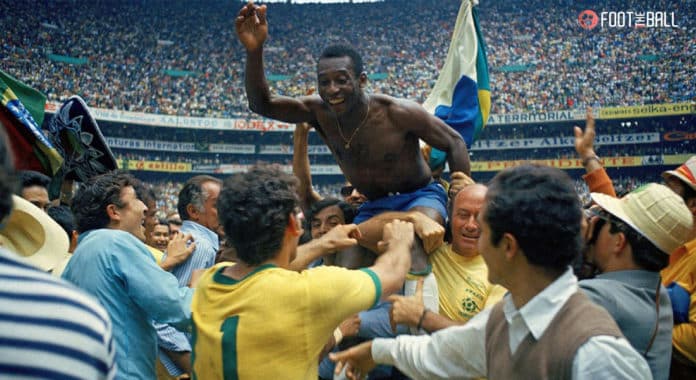After 22 editions, no nation at the FIFA World Cup has been more successful than Brazil. The Selecao have won the trophy five times in 1958, 1962, 1970, 1004 and 2002. Brazil remains one of the most obsessed football nations in the world. Over the years, Brazil has produced some phenomenal footballers, such as the legend Pele, Garrincha, Vava, Didi, Socrates, Ronaldo, Carlos Alberto Torres, Ronaldinho and many more.
Wearing their famous yellow shirts, the Brazilian have dazzled many at the highest level. In fact, the colour yellow is now synonymous in football with the Selecao. However, that was not always the case. In the earlier days of existence, the Brazilian national football team used to wear a white kit.
In the first four World Cups, i.e. 1930, 1934, 1938, and 1950, Brazil played in all whites. So why did they change to yellow, and why the white colour was entirely done away with? The white jersey has not been considered even as an away kit.
This is due to one chapter in Brazilian football that still today is considered by many to be the worst humiliation suffered by the nation in football.
The ghost of 1950 FIFA World Cup
The 1950 World Cup was the first to be held after the Second World War and was hosted by Brazil. The Selecao had a brilliant team that crushed all who came its way to reach the final four. During that edition, FIFA conducted a new experiment. Instead of knockout matches, they opted for the round-robin format, meaning each semi-finalist would play each other.
Brazil won its first two matches, while Uruguay drew one and won one. The two teams met for the final game, which essentially became a final. Everyone had dubbed Brazil the favourites, and the President of FIFA, Jules Rimet, had prepared his speech in Portuguese, Brazil’s most spoken language. However, Uruguay would make a comeback after falling 1-0 behind and scoring two goals to silence the 2,00,000 fans into stunned silence. Many people refused to believe that Brazil had lost, and the pain remains even after five World Cup titles. This is still considered to be one of the biggest shock wins in World Cup history.
Pelé made Brazil's kit the most famous of any sports team in the world.
But why is it yellow, green, and blue?
It's a story that involves crushing defeat, the Holy Roman Empire, Napoleon's sister-in-law, and dragons… pic.twitter.com/60QsrLaJoR
— The Cultural Tutor (@culturaltutor) December 30, 2022
The defeat invoked such trauma that Brazil wanted to try a new kit for the next World Cup. So a competition was organised to design the new kit. It was won by a 19-year-old illustrator Aldyr Schlee who designed a new kit based on the national flag colours, which were yellow, blue and green. This jersey was called the Camisa Canarinho, which is still in use to date.
Of the first five FIFA World Cups they played wearing the famed yellow kit, Brazil won three World Cups, making the kit iconic.
The story of the Brazilian flag is equally intriguing and interesting.
Read More:
The History of the Brazilian flag
Brazil’s flag came into existence when they declared independence from Portugal in 1822. However, it remained a monarchy, and Pedro I became the first emperor who was from the House of Braganza, whose symbol was a green wyvern, a legendary two-legged winged dragon.
Meanwhile, his wife, Maria Leopoldina, was a princess from the Austro-Hungarian empire. The rulers of the empire were from the House of Habsburg, whose coat of arms was yellow in colour. This formed the basis of the new Brazilian flag. However, the flag still did not have the blue circle it sports today.
That only came into existence in 1889 when Brazil became a republic, and a new flag had to be designed. In the new flag, a blue circle was added to the flag, with a white band running in the middle with Ordem e Progresso (Order and Progress) written on it and stars inside the circle. This represented the night skyline over Rio de Janeiro on November 15, 1889, when Brazil overthrew the monarchy and became a republic. The stars added were also of different sizes, representing each area’s size under different geographical areas.
Thus the new flag of Brazil was formed, which is still in use and formed the basis of their historical jersey.
*This article is sponsored by Khelo India, a flagship program to inculcate a sporting culture in the country.




